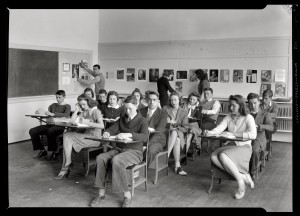 Most of the students who enroll in the Introduction to Creative Nonfiction course at the university where I teach have little to no knowledge of the genre and even less of the personal essay. So, the first assignment I give is to write an autobiographical essay with the following requirements:
Most of the students who enroll in the Introduction to Creative Nonfiction course at the university where I teach have little to no knowledge of the genre and even less of the personal essay. So, the first assignment I give is to write an autobiographical essay with the following requirements:
1. You may begin at any point. This isn’t your life history, it’s your story. Think about how you got here, how you got to where you are sitting right now.
2. Write at least two pages, no more than four; you’ll need to decide what’s significant and relevant.
3. Your autobiography must be segmented, and there must be recognizable space between the segments.
When students bring their finished essays to class, I collect them and keep them for one week, sometimes longer. Invariably, the students become nervous after handing in their lives on paper without getting immediate feedback. They will e-mail me, drop by the office, or stay after class to ask if they can submit a revision or add a paragraph.
They worry that they’ve left something out.
While they wait, we read personal essays—artful renderings of vulnerability and honesty that create an intimate connection between a writer and the reader—essays that give us permission to be who we are, such as Cheryl Strayed’s “The Love of My Life,” Steven Church’s “I’m Just Getting to the Disturbing Part,” and Victor LaValle’s “Long Distance.”
Meanwhile, I read the students’ autobiographies: their accomplishments and achievements, their stories of siblings and success, big moves and big moments. Some of the students title their segments (years, locations, grades in school); others use numbers. Some use phrases, song lyrics even. Some simply segment: prose, white space, prose.
I eventually hand back the students’ autobiographies; I have added no comments, no markings, not even a check mark. I explain to the students that what they’ve written is an application essay, the kind of essay you write for admission to a university, maybe for a scholarship or a study-abroad semester. It’s as if they’re trying to convince me. But, I tell them, I don’t want you to write an Admissions Essay. I want you to write a Permission Essay.
The Admissions Essay is bravado. The Permission Essay is brave. The Admissions Essay sets you apart from everyone else. The Permission Essay sets you as part of humanity. Finally, the Admissions Essay touts all that you know and how. The Permission Essay—the personal essay—asks what you don’t know and why. The personal essay gives you permission to wonder after that which cannot be known, to divulge self-doubt, measure missteps, and above all, to allow the reader to feel—as Phillip Lopate describes in his introduction to The Art of the Personal Essay—“less lonely and freakish.”
For the students’ next assignment, I ask them to return to their autobiographies, choose one of the white spaces between the segments, and begin: “What I didn’t say here was…”
And I explain: Write about what was lurking in your mind as you wrote the first version. Write what you thought or what you remembered but dared not write. Ultimately, those white spaces in your autobiography are the material for this class, for the personal essay, and the only thing you have to convince anyone of is your humanity.
—
Jill Talbot is the author of a memoir, Loaded (Seal Press, 2007), the co-editor of The Art of Friction: Where (Non) Fictions Come Together (University of Texas Press, 2008), and the editor of Metawritings: Toward a Theory of Nonfiction (University of Iowa Press, 2012).

5 comments
Kathy Powers says:
Mar 13, 2013
As a former English teacher (who probably was more of a writing teacher now that I think of it), I LOVE your idea. What a great way to get kids to explore what they DIDN’T put on the page. Excellent.
MARY COLLINS says:
Mar 16, 2013
I love this! Especially the idea of the bravado vs. the brave. Such a novel way of presenting this angle on the essay, and something I see staying with me as a mental flag whenever I ask myself, What is it I’m really trying to say here? Thank you for this wonderful essay.
SUSAN O'NEILL says:
Jul 7, 2013
I will use author’s suggestion about the white space…what did I leave out here? Very handy reminder of putting in more specificity. Thank you for this.
Assignment #8 – finding stories « Storytelling says:
Nov 6, 2013
[…] Some additional links to reading on the topic of memoir: ”The Permission Essay sets you as part of humanity. Finally, the Admissions Essay touts all that you know and how. The Permission Essay—the personal essay—asks what you don’t know and why…” https://brevitymag.com/craft-essays/permission_essay/ […]
Catherine Carson says:
May 22, 2014
As others have said, the note about writing what’s in the white space is significant. I wonder if I can relay this to my fiction course, as I write nonfiction but teach fiction.